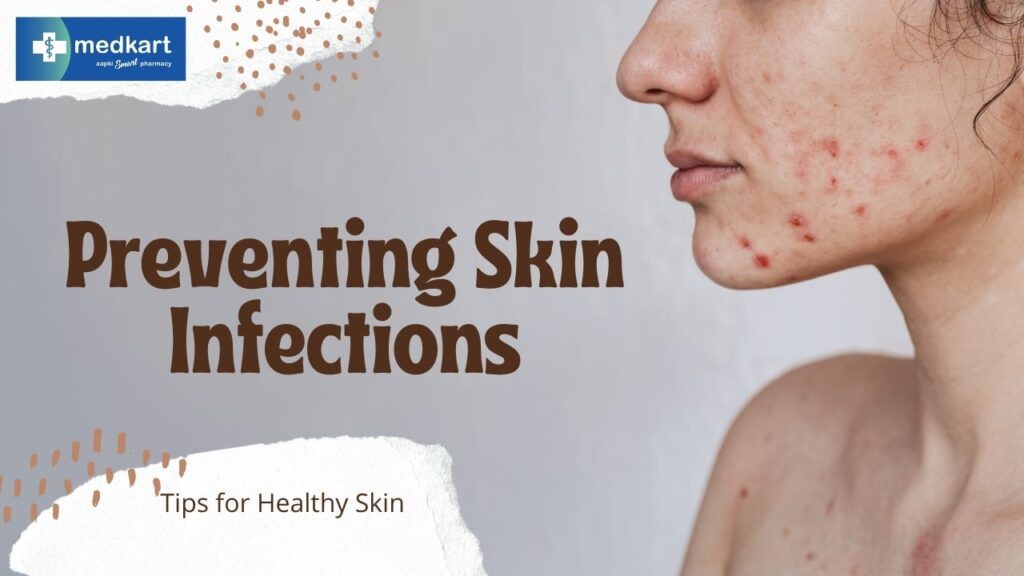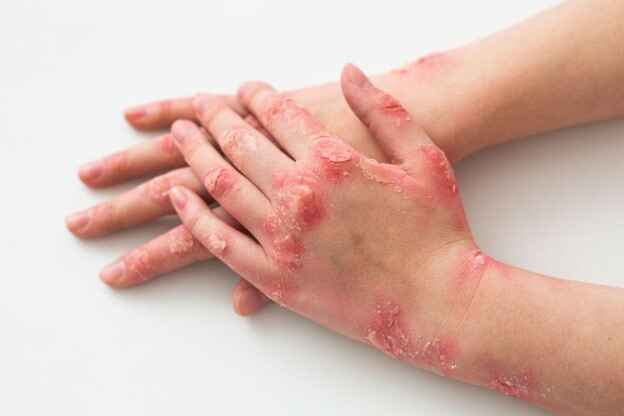Last updated on April 10th, 2025 at 12:33 pm

Our skin, the body’s largest organ, plays a critical role in protecting us from external threats. However, this vital barrier is also vulnerable to various infections caused by bacteria, viruses, fungi, and allergens. Maintaining healthy skin is essential not only for aesthetics but also for overall well-being. It’s important to know the types of skin infections, their causes, and effective strategies to prevent them, to address popular concerns such as skin allergies, fungal skin infections, and common skin diseases.
Below is an image of types of skin infections with pictures

Understanding Types of Skin Infections
Skin infections can be broadly classified into four main categories :
1. Bacterial Skin Infections
Bacterial skin infections occur when bacteria enter the skin through cuts, scratches, or open wounds. Common examples include:
- Impetigo : A contagious infection, often seen in children, characterized by red sores or blisters.
- Cellulitis : A painful infection of deeper skin layers, causing redness and swelling.
- Folliculitis : Inflammation of hair follicles, resulting in red, bumpy patches.
Photos of bacterial skin infections often show redness, swelling, and pus-filled blisters. These symptoms require immediate medical attention.

2. Viral Skin Infections
Viral infections are caused by viruses and can range from mild to severe. Examples include:
- Warts: Caused by the human papillomavirus (HPV), warts are rough, raised bumps on the skin.
- Herpes Simplex Virus (HSV): Known for causing cold sores or genital sores.
- Chickenpox and Shingles: Resulting from the varicella-zoster virus, these conditions lead to itchy rashes and blisters.
These infections are often contagious, highlighting the need for preventive measures like vaccination and hygiene practices.
3. Fungal Skin Infections
Fungi thrive in warm, moist environments, making areas like the feet and groin particularly vulnerable. Common fungal infections include:
- Athlete’s Foot (Tinea Pedis) : Characterized by itching, burning, and peeling skin between the toes.
- Ringworm (Tinea Corporis) : A circular, red, scaly rash with clear edges.
- Candidiasis : A yeast infection that affects moist areas, such as the mouth or under the breasts.
Regularly inspecting areas prone to moisture and maintaining cleanliness are key to preventing fungal skin infections.
4. Allergic and Other Skin Conditions
Allergic reactions can trigger skin issues ranging from mild irritation to severe rashes. Examples include:
- Eczema (Atopic Dermatitis): A chronic condition leading to itchy, inflamed patches.
- Contact Dermatitis: A reaction caused by allergens or irritants, such as cosmetics or poison ivy.
- Hives (Urticaria): Raised, itchy welts often caused by food, medications, or environmental factors.
Types of Skin Problems and Their Symptoms
Understanding types of skin problems can help in identifying and addressing issues promptly. Below is a table summarizing some skin diseases names, their causes, and symptoms :
| Skin Disease Name | Cause | Symptoms |
| Psoriasis | Autoimmune | Red, scaly patches |
| Acne | Bacterial/Hormonal | Pimples, blackheads, cysts |
| Scabies | Parasitic Infestation | Intense itching, rash |
| Vitiligo | Loss of pigment | White patches on the skin |
Skin infections pictures can be helpful in visually recognizing these conditions, but always consult a dermatologist for an accurate diagnosis.

Tips for Preventing Skin Infections
Preventing skin infections is an essential part of maintaining overall health. Since your skin acts as a shield against harmful microbes, keeping it clean and healthy minimizes the risk of infections caused by bacteria, viruses, fungi, and allergens. Here’s an in-depth look at effective ways to protect your skin from infections and keep it functioning at its best.
1. Prioritize Good Hygiene
Hygiene is the cornerstone of preventing skin infections. Proper cleaning habits reduce the risk of bacteria and other microorganisms accumulating on your skin.
- Wash Your Hands Frequently : Use soap and warm water to wash your hands for at least 20 seconds, especially after using the restroom, before eating, and after touching shared surfaces.
- Shower Daily : Regular showers eliminate dirt, sweat, and bacteria. Shower within an hour after working out or having heavy sweating to avoid microbial multiplication.
- Change your linen and towel frequently : Bacteria and fungi are left on damp or dirty fabric. Change your towels, pillowcases, and bedding regularly to limit exposure
2. Keep your skin clean and dry
Extra moisture in the skin makes a good setting for fungal infections like athlete’s foot and candidiasis.
- Dry Thoroughly : Dry areas that are prone to moisture, such as between your toes, under your arms, and in skin folds, after bathing.
- Wear Breathable Fabrics : Wear loose, moisture-wicking clothing made from cotton or synthetic materials designed to keep skin dry.
- Avoid Prolonged Dampness : Change out of wet clothing or swimsuits as soon as possible to prevent fungal growth.
3. Protect the Skin Barrier
The skin barrier is one way to shield, and an impaired skin barrier increases infection.
- Intact prevention : The importance is maintaining its integrity.
- Moisturize regularly : Dry skin becomes prone to cracking for bacterial invasion. Use fragrance-free moisturizer daily to keep hydrated.
- Use Sunscreen : Ultraviolet (UV) rays can weaken your skin’s defenses. Use broad-spectrum sunscreen with at least SPF 30 on exposed skin each day, even on cloudy days.
- Avoid Over-Cleansing : Frequent washing or using harsh cleansers can strip your skin of its natural oils, compromising the protective barrier. Use gentle cleansers.
4. Avoid Skin Injuries
Open wounds are an entry route for bacteria and viruses. Take precautions for your skin against accidental injuries.
- Be Careful with Sharp Instruments : While shaving or using tools, take your time to avoid cuts.
- Wear Protective Clothing : Wearing gloves or proper clothing while gardening, cooking, or performing work that could cause scrapes or burns is advisable.
- Treat minor injuries immediately : clean cuts and scrapes with soap and water, apply an antiseptic, and cover with a clean bandage to prevent infection.
5. Manage Skin Allergies Proactively
Allergic reactions can weaken the skin and lead to infections, especially if scratching occurs.
- Identify Triggers : Common allergens include certain fabrics, fragrances, dyes, and cleaning products. Keep a diary to pinpoint and avoid irritants.
- Perform Patch Tests : When using new skincare products or detergents, test them on a small patch of skin to check for allergic reactions before full use.
- Use Hypoallergenic Products : Choose gentle, dermatologically tested products to minimize the risk of skin irritation.
6. Healthy Lifestyle
Your lifestyle goes a long way in supporting the immunity of your skin to disease.
- Nutrient-Rich Diet : Eat foods rich in vitamins A, C, D, and E, along with zinc and omega-3 fatty acids, to help repair and defend your skin.
- Hydrate : Drink plenty of water to keep your skin elastic and remove toxins.
- Exercise Frequently : Exercise keeps the blood flow active, improving the transport of nutrients to skin and elimination of toxins.
7. Do Not Share Personal Goods
Microorganisms are quickly spread by sharing personal stuff. The following is to minimize the possibility:
- Do Not Share Towel or Razor : These can be infected with bacteria and fungus. Use your own and regularly clean them.
- Use Your Own Footwear : Avoid borrowing shoes, socks, or slippers to prevent fungal infections like athlete’s foot.
- Carry Personal Items : If you’re visiting communal areas like gyms or pools, bring your own mat, towel, and toiletries.
8. Be Mindful of Communal Environments
Places like gyms, locker rooms, and swimming pools are breeding grounds for microbes.
- Wear Foot Protection : Always wear flip-flops or shower shoes in communal areas to avoid fungal infections.
- Clean Shared Equipment : Use disinfectant to clean gym equipment before and after use.
- Do not Sit on Wet Surfaces : Have a clean towel or clothing barrier when sitting on public benches or chairs.
9. Boost Your Immune System
A strong immune system helps your body fight off infections effectively.
- Get Enough Sleep : Aim for 7–9 hours of quality sleep each night to allow your body time to repair itself.
- Reduce Stress : Chronic stress weakens the immune system. Practice mindfulness, yoga, or meditation to manage stress levels.
- Stay Vaccinated : Vaccines like those for chickenpox or HPV can prevent certain viral skin infections.
10. Know When to Seek Medical Help
Despite your best efforts, some skin infections may still occur. Recognizing early signs of infection can prevent complications.
- Watch for Symptoms : Redness, swelling, pain, warmth, and pus are common indicators of infection.
- Seek Timely Treatment : If an infection worsens or spreads, consult a dermatologist or healthcare provider promptly.
- Follow Medical Advice : Complete prescribed treatments, such as antibiotics or antifungal medications, to ensure full recovery.
Conclusion
Skin infections are common but preventable with the right care and attention. By understanding the types of skin infections—whether viral, bacterial, or fungal—and adopting healthy habits, you can keep your skin radiant and infection-free.
Preventing skin infections is about adopting consistent hygiene practices, protecting your skin barrier, and fostering a healthy lifestyle. By being proactive and attentive, you can minimize your risk and enjoy healthy, resilient skin. Your skin is your body’s first line of defense—give it the care it deserves !
FAQs On Preventing Skin Infections: Tips for Healthy Skin
1. How can I prevent skin infections caused by bacteria?
Prevent bacterial skin infections by maintaining good hygiene, such as washing your hands regularly and keeping wounds clean and covered. Avoid sharing personal items like towels or razors, and treat cuts or scrapes promptly with antiseptic. Keeping your skin moisturized can also help maintain its natural barrier against bacteria.
2. What steps can I take to avoid fungal skin infections?
To prevent fungal infections, keep your skin clean and dry, especially in areas prone to moisture like between the toes or under skin folds. Wear breathable clothing and change out of sweaty or wet clothes promptly. Use antifungal powders or sprays in areas like your feet if you’re prone to fungal infections.
3. How can I protect my skin if I have allergies or sensitive skin?
Identify and avoid known allergens or irritants, such as certain fabrics, fragrances, or cleaning products. Use hypoallergenic, dermatologist-recommended skincare products and perform patch tests before trying anything new. Moisturize daily to strengthen your skin’s barrier and prevent cracking or irritation.
Related Links :
Common Skin Infections
Anti Allergy Medicine for Skin
Home Remedies and Chickenpox Medication
